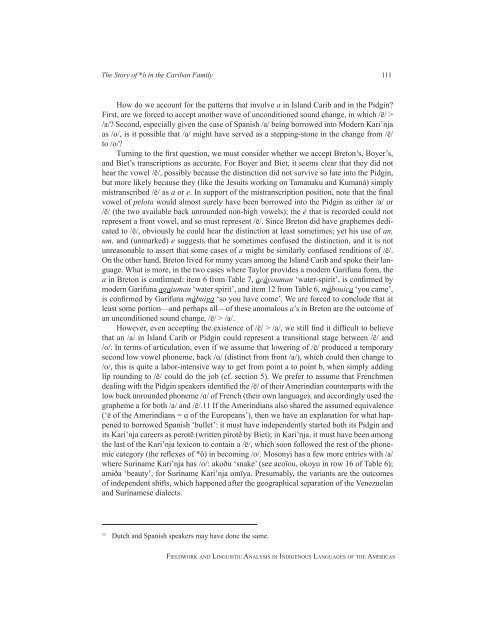Fieldwork and Linguistic Analysis in Indigenous ... - ScholarSpace
Fieldwork and Linguistic Analysis in Indigenous ... - ScholarSpace
Fieldwork and Linguistic Analysis in Indigenous ... - ScholarSpace
You also want an ePaper? Increase the reach of your titles
YUMPU automatically turns print PDFs into web optimized ePapers that Google loves.
The Story of *ȏ <strong>in</strong> the Cariban Family 111<br />
How do we account for the patterns that <strong>in</strong>volve a <strong>in</strong> Isl<strong>and</strong> Carib <strong>and</strong> <strong>in</strong> the Pidg<strong>in</strong>?<br />
First, are we forced to accept another wave of unconditioned sound change, <strong>in</strong> which /ë/ ><br />
/a/? Second, especially given the case of Spanish /a/ be<strong>in</strong>g borrowed <strong>in</strong>to Modern Kari’nja<br />
as /o/, is it possible that /a/ might have served as a stepp<strong>in</strong>g-stone <strong>in</strong> the change from /ë/<br />
to /o/?<br />
Turn<strong>in</strong>g to the first question, we must consider whether we accept Breton’s, Boyer’s,<br />
<strong>and</strong> Biet’s transcriptions as accurate. For Boyer <strong>and</strong> Biet, it seems clear that they did not<br />
hear the vowel /ë/, possibly because the dist<strong>in</strong>ction did not survive so late <strong>in</strong>to the Pidg<strong>in</strong>,<br />
but more likely because they (like the Jesuits work<strong>in</strong>g on Tamanaku <strong>and</strong> Kumaná) simply<br />
mistranscribed /ë/ as a or e. In support of the mistranscription position, note that the f<strong>in</strong>al<br />
vowel of pelota would almost surely have been borrowed <strong>in</strong>to the Pidg<strong>in</strong> as either /a/ or<br />
/ë/ (the two available back unrounded non-high vowels); the é that is recorded could not<br />
represent a front vowel, <strong>and</strong> so must represent /ë/. S<strong>in</strong>ce Breton did have graphemes dedicated<br />
to /ë/, obviously he could hear the dist<strong>in</strong>ction at least sometimes; yet his use of an,<br />
um, <strong>and</strong> (unmarked) e suggests that he sometimes confused the dist<strong>in</strong>ction, <strong>and</strong> it is not<br />
unreasonable to assert that some cases of a might be similarly confused renditions of /ë/.<br />
On the other h<strong>and</strong>, Breton lived for many years among the Isl<strong>and</strong> Carib <strong>and</strong> spoke their language.<br />
What is more, <strong>in</strong> the two cases where Taylor provides a modern Garifuna form, the<br />
a <strong>in</strong> Breton is confirmed: item 6 from Table 7, acáyouman ‘water-spirit’, is confirmed by<br />
modern Garifuna agaiumau ‘water spirit’, <strong>and</strong> item 12 from Table 6, mábouica ‘you came’,<br />
is confirmed by Garifuna mábuiga ‘so you have come’. We are forced to conclude that at<br />
least some portion—<strong>and</strong> perhaps all—of these anomalous a’s <strong>in</strong> Breton are the outcome of<br />
an unconditioned sound change, /ë/ > /a/.<br />
However, even accept<strong>in</strong>g the existence of /ë/ > /a/, we still f<strong>in</strong>d it difficult to believe<br />
that an /a/ <strong>in</strong> Isl<strong>and</strong> Carib or Pidg<strong>in</strong> could represent a transitional stage between /ë/ <strong>and</strong><br />
/o/. In terms of articulation, even if we assume that lower<strong>in</strong>g of /ë/ produced a temporary<br />
second low vowel phoneme, back /ɑ/ (dist<strong>in</strong>ct from front /a/), which could then change to<br />
/o/, this is quite a labor-<strong>in</strong>tensive way to get from po<strong>in</strong>t a to po<strong>in</strong>t b, when simply add<strong>in</strong>g<br />
lip round<strong>in</strong>g to /ë/ could do the job (cf. section 5). We prefer to assume that Frenchmen<br />
deal<strong>in</strong>g with the Pidg<strong>in</strong> speakers identified the /ë/ of their Amer<strong>in</strong>dian counterparts with the<br />
low back unrounded phoneme /ɑ/ of French (their own language), <strong>and</strong> accord<strong>in</strong>gly used the<br />
grapheme a for both /a/ <strong>and</strong> /ë/.11 If the Amer<strong>in</strong>dians also shared the assumed equivalence<br />
(‘ë of the Amer<strong>in</strong>dians = ɑ of the Europeans’), then we have an explanation for what happened<br />
to borrowed Spanish ‘bullet’: it must have <strong>in</strong>dependently started both its Pidg<strong>in</strong> <strong>and</strong><br />
its Kari’nja careers as perotë (written piroté by Biet); <strong>in</strong> Kari’nja, it must have been among<br />
the last of the Kari’nja lexicon to conta<strong>in</strong> a /ë/, which soon followed the rest of the phonemic<br />
category (the reflexes of *ô) <strong>in</strong> becom<strong>in</strong>g /o/. Mosonyi has a few more entries with /a/<br />
where Sur<strong>in</strong>ame Kari’nja has /o/: akoðu ‘snake’ (see acoïou, okoyu <strong>in</strong> row 16 of Table 6);<br />
amɨða ‘beauty’, for Sur<strong>in</strong>ame Kari’nja omïya. Presumably, the variants are the outcomes<br />
of <strong>in</strong>dependent shifts, which happened after the geographical separation of the Venezuelan<br />
<strong>and</strong> Sur<strong>in</strong>amese dialects.<br />
11 Dutch <strong>and</strong> Spanish speakers may have done the same.<br />
fieldwork <strong>and</strong> l<strong>in</strong>guistic analysis <strong>in</strong> <strong>in</strong>digenous languages of the americas

















